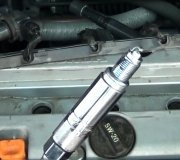Here's some things to consider. 1. Stop on a small incline, shift to neutral, release the brake, then see if the truck creeps downhill on its own. If not, suspect a dragging brake caliper. 2. Check for an exhaust leak ahead of the oxygen sensor. Between the pulses of exhaust gas, the momentum creates little puffs of vacuum that can suck in outside air. The oxygen in that air will be detected as a lean condition. The Engine Computer will try to correct that by commanding more fuel to be sprayed in. 3. GM is famous for fuel pressure regulators leaking raw fuel into the vacuum hose. Pull that hose off and see if it is wet inside. You will typically also see black smoke from the tail pipe. 4. Use a scanner to read live sensor data while on a test drive. The oxygen sensor should be changing from "rich" to "lean" a couple of times per second. If it stays on "lean" too long suspect a vacuum leak. The computer will respond by adding more fuel but that will increase engine speed which increases the amount of unmetered air coming in through the leak. The O2 sensor will continue to see that extra oxygen. 5. If you have six individual injectors, GM has a huge problem with mismatched injectors. Chrysler buys their injectors from Bosch in flow-matched sets of six or eight and has almost no injector trouble. GM just grabs a handful from a large bin with no concern about their varying flow rates. When one flows a little less than the rest, its mixture is lean and that extra unburned oxygen shows up at the oxygen sensor. Since it doesn't know which cylinder(s) is lean, the Engine Computer commands more fuel from all six injectors, even those that are flowing at higher rates. That resulting too much fuel from some cylinders is not detected because O2 sensors only detect unburned oxygen, not fuel. 6. Use the scanner to view "long-term fuel trims" (LTFT) and "short-term fuel trims" (STFT). Short-term fuel trims means the Engine Computer is varying how long it holds the injectors open during each pulse based on what the needs are calculated to be and based on what the oxygen sensor is reporting right now. Negative numbers means the computer is requesting a little less fuel to keep the average mixture correct. Long-term fuel trims tell a bigger story. Large positive numbers means the computer has seen the need to add fuel over the long haul. It has put these numbers into memory and uses them as the new starting point for the short-term values each time you drive the truck. You need to figure out why it's requesting so much more fuel over the factory pre-programmed values. If the numbers are high negative, the computer sees there's too much fuel entering the engine and is trying to reduce that amount, apparently without success. That could mean extra fuel is entering in a way the computer has no control of. Two examples would be a leaking injector that doesn't close completely between pulses or fuel supply pressure that is too high. Fuel pressure is not monitored so no related diagnostic fault codes will be set
SPONSORED LINKS
Thursday, March 10th, 2011 AT 7:17 PM





